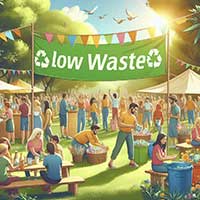 Feeling a tug of concern when you heave a full trash bag to the curb? You're not alone. In a world increasingly grappling with overflowing landfills and plastic pollution, the idea of reducing the amount of waste we produce at home is gaining traction. Perhaps you've seen impressive images of people fitting a year's worth of trash into a small jar and thought, "That's impossible for me!" This article is about taking the first steps – simple, affordable changes you can implement right now in your own home to significantly reduce your waste footprint without feeling overwhelmed.
Feeling a tug of concern when you heave a full trash bag to the curb? You're not alone. In a world increasingly grappling with overflowing landfills and plastic pollution, the idea of reducing the amount of waste we produce at home is gaining traction. Perhaps you've seen impressive images of people fitting a year's worth of trash into a small jar and thought, "That's impossible for me!" This article is about taking the first steps – simple, affordable changes you can implement right now in your own home to significantly reduce your waste footprint without feeling overwhelmed.
It’s true that achieving a near-zero-waste lifestyle can be challenging and requires significant commitment. But the good news is you don't have to be perfect to make a difference. Think of it as kicking off your low-waste journey, one easy step at a time.
The question of "why bother?" is a valid one, especially when the problem feels so large. The reality is, the amount of waste generated globally and individually is staggering. Much of this waste, particularly plastics, takes hundreds or even thousands of years to break down, if ever, clogging landfills and polluting our oceans and natural environments. This pollution harms wildlife, enters our food chain, and contributes to greenhouse gas emissions. Producing new goods from raw materials also consumes vast amounts of energy and resources, contributing to habitat destruction and climate change. Every item we discard has an environmental cost associated with its creation, transportation, use, and disposal. By reducing our waste, we directly lessen these burdens on the planet.
Beyond the environmental imperative, there's a compelling financial argument for reducing household waste. When you buy products with excessive packaging, you're often paying for that packaging. When you throw away spoiled food, you're literally throwing away money. Opting for reusable alternatives, buying in bulk, and simply being more mindful of what you purchase can lead to significant savings over time. It’s a tangible benefit that makes the effort feel even more worthwhile. Furthermore, a less cluttered home, often a byproduct of consuming and discarding less, can contribute to a greater sense of peace and well-being. Your low-waste journey is not just about the environment; it’s also an investment in your own financial health and living space.
So, where does all this waste in our homes actually come from? Taking a moment to observe what you throw away in a typical day or week can be incredibly insightful. You might be surprised by the volume and types of materials filling your bins. One of the most significant culprits is packaging. Everything from plastic wrap on vegetables, cardboard boxes for deliveries, plastic containers for food, and the myriad layers protecting electronics and other goods contributes substantially to our waste stream.
Food waste is another major component of household trash. Uneaten leftovers, expired produce, and scraps from meal preparation often end up in the landfill, where they decompose anaerobically (without oxygen) and produce methane, a potent greenhouse gas. It’s estimated that a significant percentage of food produced globally is lost or wasted, representing a colossal waste of resources used in its production, transportation, and storage.
Single-use items have become ubiquitous in our busy lives, contributing a huge volume of easily avoidable waste. Think about the disposable coffee cup used for a few minutes, the plastic fork from a takeout meal, plastic straws, paper napkins, and plastic bags from the grocery store. These items are designed for convenience but have a very short lifespan before becoming persistent waste.
Beyond packaging and disposables, other common sources of waste include old or unwanted items. Clothing that's gone out of style or no longer fits, outdated electronics, broken gadgets, and unwanted furniture often end up in the trash when they could potentially be donated, repaired, or recycled through specialized programs. Paper waste, despite increased digital communication, still fills our bins with junk mail, paper towels, product वेस्टिंग, and old documents. Identifying these common sources in your own home is the first step to tackling them effectively.
Now that we have a clearer picture of where waste originates, let's talk about taking those crucial first steps – the easy wins that can make an immediate difference without requiring a complete lifestyle overhaul. One of the most impactful initial actions is simply learning to refuse single-use items. This requires a bit of mindfulness and speaking up, but it becomes second nature surprisingly quickly. When ordering a drink, specify "no straw, please." When getting takeout, request "no plastic cutlery." At the grocery store or checkout counter, proactively say "I don't need a bag" if you're only purchasing one or two small items. This simple act of refusal prevents waste from entering your hands (and eventually the landfill) in the first place.
Building the habit of bringing your own reusable bags is another cornerstone of low-waste living. Keep a few in your car, by the front door, or folded in your purse or backpack so you're never caught without one. Many stores now offer incentives or charge for plastic bags, providing a financial nudge towards reusables.
Similarly, investing in a reusable water bottle is an easy and impactful swap. Access to clean drinking water is readily available in many places, making single-use plastic bottles unnecessary and a significant source of avoidable waste. Carrying your own bottle also saves you money in the long run.
For coffee and tea drinkers, bringing your own reusable cup to cafes is another excellent starting point. Many coffee shops offer a small discount for using your own cup, adding a financial incentive to the environmental benefit. These simple acts of remembering and using reusable alternatives directly reduce the demand for and disposal of single-use items, making them powerful first steps on your low-waste journey.
Moving beyond refusing and remembering reusables, there are many simple swaps for everyday items that can significantly cut down on waste over time. Consider the humble paper towel. Switching to cloth rags or washable towels for cleaning up spills and everyday tasks is an easy transition. Old t-shirts or towels can be cut up and repurposed for this, making it a truly zero-cost swap.
In the kitchen, swapping plastic food wrap for reusable alternatives like glass containers with lids, beeswax wraps, or even just repurposing jars and containers from products you've purchased (like jam jars or yogurt tubs) can dramatically reduce plastic waste.
In the bathroom, traditionally a source of significant plastic waste, simple swaps are also readily available. Switching from disposable razors to a safety razor with replaceable blades, which are often recyclable, is a more durable and less wasteful option. Opting for bamboo toothbrushes instead of plastic ones, and choosing bar soap or shampoo bars over liquid products in plastic bottles, are easy transitions that reduce plastic packaging waste. For those open to it, exploring reusable feminine hygiene products like menstrual cups or cloth pads can also significantly reduce ongoing waste. These swaps not only cut down on trash but often lead to cost savings over time as reusable options are a one-time or less frequent purchase.
Understanding the "reduce, reuse, recycle" hierarchy is fundamental to a low-waste lifestyle. However, it's crucial to understand the order of priority, which is often overlooked.
Reduce is at the top for a reason. The most effective way to reduce waste is to prevent it from being created in the first place. This means consuming less overall, choosing products with minimal or no packaging, buying in bulk when possible (and using your own containers!), and opting for durable items that will last. Reducing demand sends a powerful message to manufacturers and lessens the resources needed for production.
Reuse comes next. Before discarding something, consider if it can be used again, either for its original purpose or a new one. This could be as simple as reusing a food container or as creative as upcycling old furniture. Reusing extends the life of products and delays or avoids them entering the waste stream.
Recycle is the third arrow, and while important, it's not a magic bullet. Recycling requires energy and resources to collect, sort, and process materials into new products. Not all materials are easily recyclable, and recycling infrastructure varies. Properly recycling keeps valuable materials out of landfills, but reducing and reusing are more impactful steps in minimizing your environmental footprint.
Finally, while not always included in the traditional hierarchy, Rot (Composting) is a crucial step for organic waste. Composting food scraps and yard waste turns them into valuable soil amendment instead of allowing them to create methane in landfills. (We'll delve deeper into composting in the next article).
Emphasizing reduction first is key. No amount of recycling can offset a high level of consumption and waste generation. By focusing on reducing what you bring into your home, you address the waste problem at its source.
As you embark on this journey, it's vital to set realistic goals. Trying to go completely zero-waste overnight is likely to lead to frustration and burnout. Instead, pick one or two areas to focus on first. Maybe this week, you'll commit to bringing your reusable bags everywhere. Next month, you might tackle reducing food waste through better meal planning. Celebrate these small victories! Every plastic bag refused, every meal planned, every reusable swap made is a step in the right direction and makes a tangible difference.
Involving your household, if applicable, is also important. Educate family members on the "why" behind these changes and work together to implement new habits. Make it a team effort, and it will be more sustainable in the long run. Remember, this is a journey, not a race to perfection. There will be times when convenience wins out, or you forget your reusable cup. Don't be discouraged. Acknowledge it and get back on track with your next conscious choice. The goal is progress, not perfection.
Summary
Embarking on a low-waste journey is an achievable and impactful way to reduce your environmental footprint and even save money. By understanding where our household waste comes from – primarily packaging, food waste, and single-use items – we can identify key areas to target. Taking simple first steps like refusing disposable items and consistently using reusable bags, water bottles, and coffee cups makes an immediate difference. Implementing simple swaps for everyday items, such as using cloth towels instead of paper or opting for bar soap, further reduces waste. Understanding the waste hierarchy, prioritizing reduction and reuse before recycling and composting, is crucial. Finally, setting realistic goals and making gradual changes ensures that your low-waste efforts are sustainable in the long term.
Conclusion
Reducing your household waste doesn't require an extreme lifestyle overhaul. It begins with awareness and a willingness to make small, deliberate changes in your daily habits. Every reusable item you choose, every disposable you refuse, and every effort to minimize packaging sends a positive ripple effect into the world. You have the power to make a difference right from your own home.
Call to Action
Ready to kick off your low-waste journey? Pick one simple step from this article – whether it's remembering your reusable bags for your next shopping trip, committing to using a reusable water bottle, or trying a simple swap like cloth napkins. Choose one action and focus on making it a consistent habit this week. Small steps truly lead to big changes over time. Join us in the next article where we'll dive deeper into mastering local recycling and composting programs to further reduce your impact!






